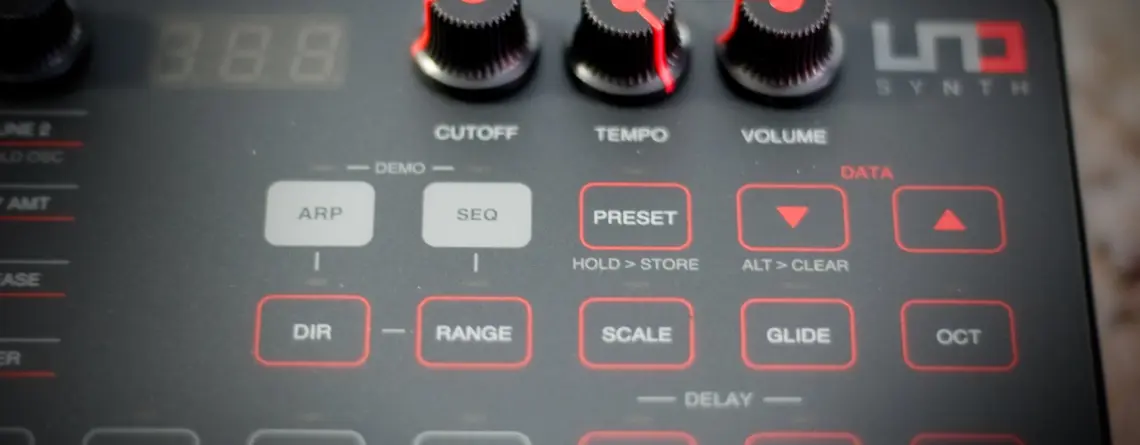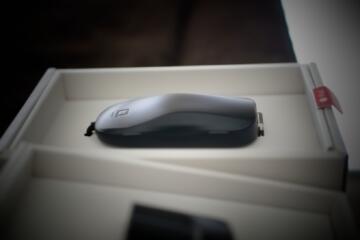The UNO Synth is Analog Reimagined
When you hear the words “Analog Synth” what comes to mind? For some it’s the nostalgic sounds of the famous Moog synths of past and present, for others it may be the joy of twisting and modulating a variety of knobs and controls. I searched for a long time to find a “cheap” analog synth but for years there was nothing that fit the bill. Recently though Behringer started cloning a number of classics starting with the famed Model D, and It seems that IK Multimedia is now riding this wave of analog resurgence with a little help from Sound Machines (a niche manufacturer of modular synths).

UNO
IK’s UNO is the marriage of classic analog sound with a modern control interface. The synth features a ton of controls to “tune” the signal coming from the two Voltage Controlled Oscillators (VCOs). Input options also include a 16 step sequencer and multi-touch 27-note chromatic/scale keyboard, there’s even an app that supports Mac/PC and iOS devices. The first time I saw the UNO I thought that there is no way this is an analog synth. It looks way too modern, but the sound that came from the device, though, quickly disproved that theory. The noises that come from this synth are extraordinary considering its size and weight. One may think that there is some medieval class circuitry processing those electrons upon first listen, but fortunately for our wallets and limited desktop real estate, there isn’t. I really don’t know how they did it but this synth is really good but it does have some quirks of course as you’ll see below.
NoNo
Using the UNO will be a little weird initially, especially if you are used to traditional “Analog Synths”. The few knobs that are there need to control multiple functions, which makes the sound manipulation process more difficult since you have to use modifiers to change what each knob controls at any given time. For example, the main four knobs control the tuning of the oscillators and also the filter and amplifier envelopes, so once you tune the OSCs you have to then change the function of the knobs to modify the attack, decay, or release for the amp and filter. These shortcomings are thankfully made up for by the ability to save presets and the inclusion of other sound modulation functions such as Dive, Scoop, Vibrato, Wah, and Tremolo. There is a delay function as well which is another easter egg that rounds out this feature-rich device.
You Know
I like the UNO Synth, it’s a breath of fresh air in a category of devices that’s existed since well beyond my years being on this planet. I admire IK Multimedia’s resolve to bring something different to the table knowing that it could have flopped spectacularly. Even though I like the concept and to some extent, execution of this device, there are a few things that could have been better, like more knobs. I really dislike the fact that so many parameters are controlled by so few knobs. I don’t think the size and cost of the device would have increased dramatically with a few more dedicated controls. At the end of the day though it’s the sound that really matters and the analog audio path does shine in that regard. Overall I welcome different interpretations of existing technology and I hope that this specific device will be refined to the point where it’s not only fun to listen to but also fun to use. In the meantime don’t hesitate to grab one as an external instrument for your DAW or sequencer, you won’t be disappointed!Update: At the time of this post, the UNO had a newer firmware available. The post will be updated once I get a chance to test the new FW.Specs
- All-analog audio path with 2 VCOs with continuously variable waveshape, noise generator, resonant multimode VCF and VCA
- 2 independent analog VCOs with Saw, Triangle, and Pulse waveforms with continuously variable shape including PWM of the square wave and a separate white noise generator
- A 2-pole multimode OTA-based sweepable analog resonant multimode filter with LPF, HPF, BPF
- LFO with Sine, Triangle, Square, Up Saw, Down Saw, Random and Sample-and-Hold to modulate Pitch, Filter and Amp
- AD (Filter) + AR (Amp) envelopes (full ADSR control available via MIDI CC or software editor)
- 40 onboard controls and LED display
- 100 onboard presets
- 10 mode, 4-octave arpeggiator
- Real-time and step edit 16-step sequencer with 20 automatable parameters
- Onboard multi-touch 27-note chromatic and scale keyboard with 13 scales
- Sync Delay audio effect and 5 performance effects
- Self-tuning with auto-tune calibration
- USB MIDI and 2.5 mm jack MIDI IN/OUT (cables included)
- Audio In to daisy chain other audio devices with no need for a mixer
- Mac/PC/iOS Editor
- Complete MIDI implementation with all parameters and clock can be controlled via MIDI CC
- Battery (4xAA Alkaline, Ni-Mh) or USB powered
- Ultra-portable and lightweight
- Designed and made in Italy
Gallery
















Discover more from Akiatech Solutions Blog
Subscribe to get the latest posts sent to your email.









